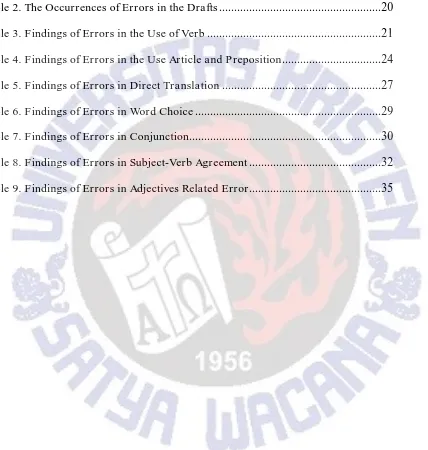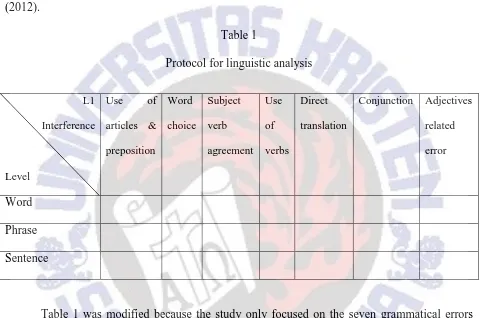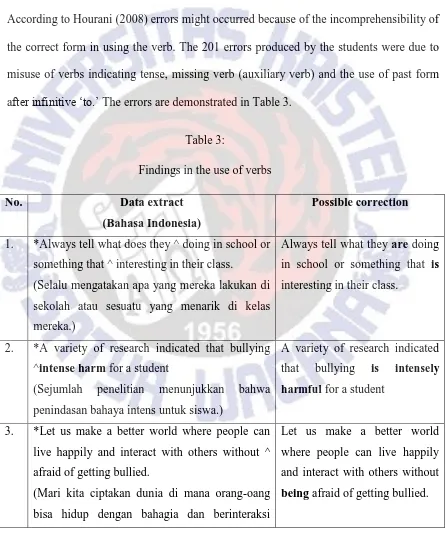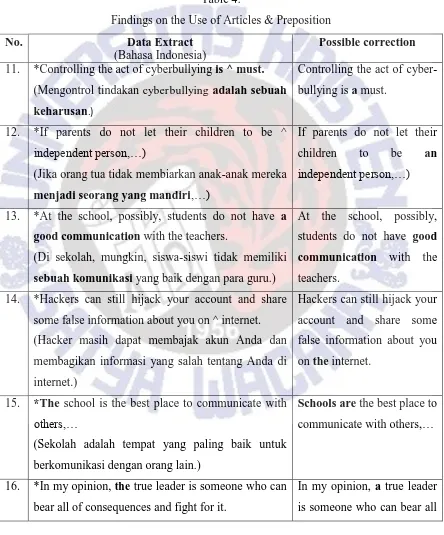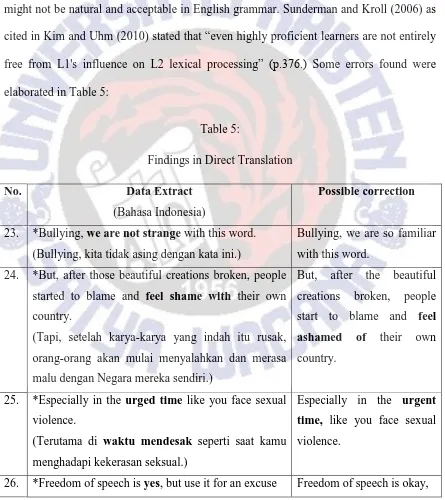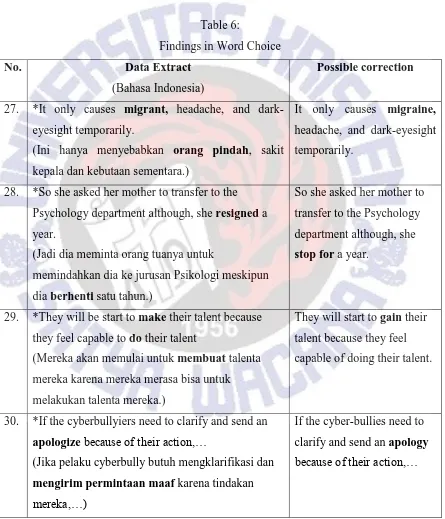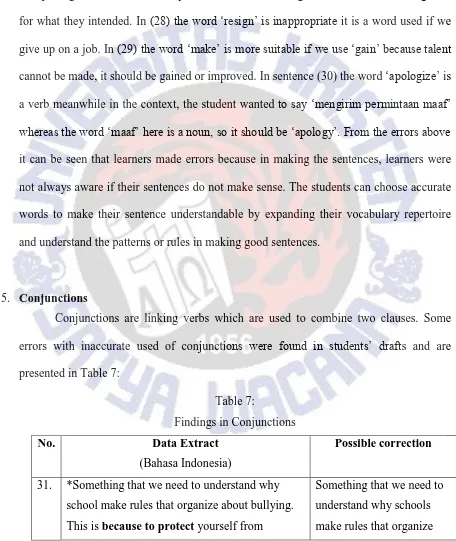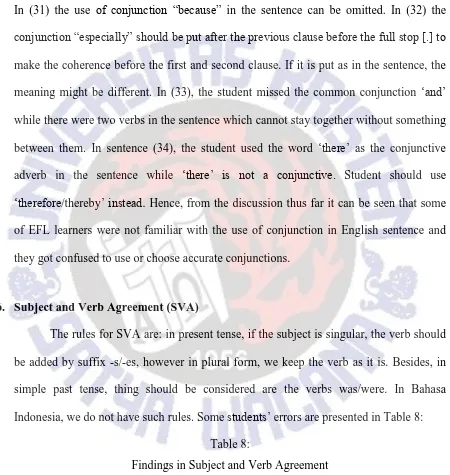i
ERRORS PRODUCED
BY STUDENTS IN THEIR PERSUASIVE ESSAYS
THESIS
Submitted in Partial Fulfillment of the Requirements for the Degree of
Sarjana Pendidikan
Chang Sese 112012076
ENGLISH LANGUAGE EDUCATION PROGRAM
FACULTY OF LANGUAGE AND ARTS
SATYA WACANA CHRISTIAN UNIVERSITY
3
COPYRIGHT STATEMENT
This thesis contains no such material as has been submitted for examination in any course or
accepted for the fulfillment of any degree or diploma in any university. To the best of my
knowledge and my belief, this contains no material previously published or written by any other
person except where due reference is made in the text.
Copyright@ 2017. Chang Sese and Dr. Joseph Ernest Mambu.
All rights reserved. No part of this thesis may be reproduced by any means without the
permission of at least one of the copyright owners or the English Language Education Program,
Faculty of Language and Arts, Satya Wacana Christian University, Salatiga.
7
TABLE OF CONTENTS
APPROVAL PAGE ... 2
COPYRIGHT STATEMENT ... 3
PUBLICATION AGREEMENT DECLARATION ... 4
PERNYATAAN PERSETUJUAN AKSES ... 5
PERNYATAAN TIDAK PLAGIAT ... 6
TABLE OF CONTENTS ... 7
LIST OF TABLE ... 9
ABSTRACT ... 10
INTRODUCTION ... 10
LITERATURE REVIEW ... 12
Error Analysis ... 12
L1 Interference in L2 Writing ... 13
Approaches to L1 Interference Study ... 15
Review of Previous Study... 15
THE STUDY ... 17
8
Research Question ... 18
Participants... 18
Data analysis ... 19
FINDINGS AND DISCUSSION ... 20
Use of verbs ... 21
Use of Article and Prepositions ... 24
Direct Translation ... 27
Word choice ... 28
Conjunction ... 30
Subject-Verb Agreement ... 32
Adjectives Related Error ... 34
CONCLUSION ... 36
ACKNOWLEDGEMENTS ... 37
REFERENCES ... 38
9
LIST OF TABLES
Table 1. Protocol for Linguistic Analysis ... 19
Table 2. The Occurrences of Errors in the Drafts ... 20
Table 3. Findings of Errors in the Use of Verb ... 21
Table 4. Findings of Errors in the Use Article and Preposition ... 24
Table 5. Findings of Errors in Direct Translation ... 27
Table 6. Findings of Errors in Word Choice ... 29
Table 7. Findings of Errors in Conjunction... 30
Table 8. Findings of Errors in Subject-Verb Agreement ... 32
10
ERRORS PRODUCED
BY STUDENTS IN THEIR PERSUASIVE ESSAYS
CHANG SESE
ABSTRACT
This paper focus on EFL learners‟ grammatical errors found in essays written in the target language. This study was conducted in the Faculty of Language and Arts, Universitas Kristen Satya Wacana, Salatiga. The data were collected from 19 drafts of students‟ persuasive essay. The data found were classified and analyzed under Sattayatham and Honsa‟s (2007) theoretical framework and interpreted by following the correct grammar rules in English. The use of verbs was found as the most frequent errors occurred in students‟ final draft, followed by the use of articles and prepositions, direct translation, word choice, conjunction, subject-verb agreement, and adjectives related error. The study suggests that the errors made by the students might because of students‟ L1. In transferring their idea from first language, students were might not used to target language rules which made the idea transferred become unacceptable in target language. The implications of this study are to find out what most frequent errors occurred by FLA UKSW students and help the teachers to minimize students‟ errors in their writing.
Key words: L2 writing, language transfer, native language, target language, error analysis, interlanguage
INTRODUCTION
Being an English as a Foreign Language (EFL) learner for 14 years and having Bahasa
Indonesia as my first language makes me think that actually my first language may affect my
foreign language acquisition, especially in writing. Some Indonesian may not be able to produce
good and correct writing form of English even when we have been taught English since we were
11
language depends on some variables such as background of education, mother tongue, literacy
skills in their first language, and the previous contact with the target language. Students‟ first
language may give impact on their progress of writing because Indonesian has different
grammatical structures from English.
EFL learners may find that writing in a target language is difficult as Heydari and
Bagheri (2012) stated that writing in native language is complex; writing in target language is
definitely more complex. Agreeing with them, as EFL learner, I believe that choosing some
appropriate words, producing a good sentence, or writing creative essay with appropriate
grammar in English is not an easy task to do. Missing some basic rules in English like putting an article “the,” forming a correct word order and translating some words from Bahasa Indonesia to
English are sort of struggles that most of EFL learners found in producing writing. Moreover, Urdaneta (2011) stated in his paper “four basic mistakes in student papers were found to be a
direct influence from L1 to L2 writing: word order, missing the verb “be”, implicit subject, and
the incorrect use of the article “the” (p.158). Maniam (2010) claimed that learners‟ first language
believed to be a negative role in influencing students‟ SLA. Based on these empirical studies, L1
interference does have a negative role and can be a troublesome for ESL learners when they are
producing writing.
Even though there have been many studies on L1 interference in L2 writing, its pedagogical aspects, especially in L1 interference errors in learners‟ writing, have not yet been
well-explored. Therefore, the aim of this research is to explore more about EFL students‟ errors
so that EFL writing teachers can pay more attention to the errors that might be influenced by students‟ first language, especially the most frequently occurring errors produced by writing
12
LITERATURE REVIEW
There were three major themes elaborated in this study: Error Analysis, L1 interference in L2
writing and approaches in L1 Interference study.
Error Analysis
Errors are often found in the process of learning a new language. According to Cunningworth (1987) as cited in Ridha (2012) “Errors are systematic deviations from the norms
of the language being learned.” (p.25.) Abi Samra (2003) as cited in Ridha (2012) also stated that
errors are considered as indispensable „devices‟ for students to learn in their process of learning,
somehow errors should be eradicated because it is considered as „flaws‟ in learning process.
In eradicating the errors produced by EFL learners, error analysis is used to find out what
errors that learners make. According to Hasyim (2002) as cited in Ridha (2012) error analysis is
a process to observe, analyze, and classify the product of learners which not accordance with the
target language rules. In analyzing learners‟ errors, the errors should be determined by the
sources of errors. Reid (1993) as cited in Kaweera (2013) stated that there are numerous research about error analysis conducted in order to find out if the sources of errors found in students‟
writing was „first language interference‟ or the other factor. Brown (2000) as cited in Ridha
(2012) also stated that there are two main sources of error analysis, they are interlingual and
intralingual. Interlingual (Interference) Errors are errors which influenced by first language. This
13 L1 Interference in L2 writing
Everyone‟s language is already structured by their native language (L1) since they were
first introduced or exposed to their L1. Maniam (2010) suggested that although human languages
have a great deal in common, which enables us to translate from one language to another without
much difficulty, they are also very different from one another in many aspects. In learning a new language, students‟ reference will be their mother tongue. Transferring idea from first language
to target language is somehow difficult for students. According to Owu-Ewie & Lomotey (2016)
the result of transferring the idea of L1 to target language is most of the sentences produced were more acceptable in students‟ native language rather than in target language since the students
seem to transfer the sentence directly. Decherts (1983) and Ellis (1997) as cited in Bhela (1999)
stated that errors from interference of first language will occur when the learners of a second
language try to rely on their mother tongue structures when they write or speak in target
language. They revealed that mother tongue is the native speakers‟ reliable linguistic resource
since it is the first language that everyone learns and knows.
As a reliable source for EFL learners, L1 might bring positive and negative impact to learners‟ process in learning the target language. According to Ellis (1997) as cited in Sukarno
(2016), positive transfer happens if learners‟ L1 grammatical forms and the target language are
similar, if they are not, negative transfer will occur. In addition, Owu-Ewie & Lomotey (2016)
argued that when L2 learners write in the target language some of their L1 characteristics show
up in their writing. They believed that many sentences that L2 learners write are more acceptable
in their native language than in English (L2) due to direct translation from L1 into English.
Another research that supports Owu-Ewie and Lomotey statement is done by Wang and Wen
14
students were more comfortable to depend on their native language in organizing their writing
and generating ideas, but in doing the task-examining and text-generating students were more
comfortable to rely on their target language. Negative transfer mostly happens to EFL learners
because they tend to rely on their first language structures which are different from their target
language structures.
Mother tongue indeed can be one of students‟ hard problems that interferes the learners‟
process of learning the target language. From the studies above, L1 interference really exist in
ESL writing fields which means that making mistakes or errors is common during the process of
learning a new thing, including learning a new language.
Approaches to L1 Interference Study
There have been numerous studies investigating L1 interference in L2 writing. In such
studies, there are four widely-used approaches which are the traditional approach Contrastive
Analysis (CA), contemporary approach Error Analysis (EA) and Interlanguage Analysis (IA) and
modern approach Contrastive Rethoric (CR) according to Latiff & Bakar, 2007 as cited in
Owue-Ewie & Lomotey (2016).
Contrastive Analysis is chosen for this study because CA is the main approach which
compares two languages [first language and target language] in linguistic study. The other three
approaches which are Interlanguage, Error Analysis, and Contrastive Rhetoric are also used for
analyzing first language influenced in producing utterances or written essays in target language,
but CA is more appropriate for this study because in analyzing the data, the errors made in
English will be compared to Bahasa Indonesia.
15
Bennui (2008) stated that Contrastive Analysis is the key approach to studying L1
Interference. According to Richard and Schmidt (2002), Contrastive analysis is an analysis
focusing on the contrast between linguistic systems (e.g., sounds and grammar) of two
languages. They added, this type of analysis was often applied in the 1950s and 1960s as part of
structural linguistics application in language teaching based on the following deductions:
a. The interference from the first language leads to the main hindrances in learning a new
language.
b. By using contrastive analysis, one can figure out what these hindrances are.
c. Contrastive analysis can be applied to teaching materials to minimize the effect of
interference.
Richards (1979) reported that Contrastive Analysis hypothesized that children will lean
on their first language structure in producing utterance in their target language and they will mix
up when the structures are different. According to Richards and Schmidt (2002) and Fang and
Xue-mei (2007, p.10) as cited in Sompong, (2014) “CA focuses on the scientific, structural
comparison of the linguistic systems of the two languages, especially the sound and grammar
systems of L1 and L2, to predict and describe second language instruction problems as well as to
find solutions to those problems” (p.3.) Sukarno (2016) added that Contrastive analysis focuses
on the differences between the grammatical structure in target language and learners‟ first
language.
Review of Previous Studies
16
participants of this research were 28 third-year EFL students who enrolled in Basic Writing
course. The students were from three different universities and seven majors. In this study, the researcher found that in students‟ essay, negative transfer of their L1 showed up more than the
positive transfer. It could be seen from the findings of L1 interference categories [vocabulary
use, phrases, clauses, and sentence structures, along with language style] that appear in students‟
essay.
The second research conducted in Ghana, Owu-Ewie and Lomotey (2016) analyzed 90
written Essays from 15 Junior High School Students from three different schools whose native
language is Akan-Fante. They found that errors influenced by students‟ L1 were produced in
translation, spelling errors, omission errors, wrong use of pronoun, and wrong word use. The
most frequent errors produced by Akan speaker students were transliteration; the second one is
omission errors; the third is spelling errors; the fourth is wrong use of pronouns; and the last is
wrong word use.
Then the next research was organized in Salatiga, Indonesia by Samingan (2016). The
participants were 30 students of English as Foreign Language learners who studied in Institute
for Islamic Studies (IAIN), Salatiga. The research was focused on students‟ L1 interference in
lexical [loanword, literal translation at word level, literal translation of L1 preposition, literal
translation of L1 adverb of manner, and literal translation of L1 comparative degree of adjective]
and syntactical level [the use of L1 structure in target language and English noun phrase, literal
translation in negation of verbal sentence, literal translation in negation of nominal sentence, and
literal translation in nominal sentence of affirmative form. In this study, Samingan concluded
17
IAIN Salatiga made most interference in syntactical level in the case of direct translation in
nominal sentence of affirmative form.
The last research was organized in Faculty of Letters, Jember University, Indonesia by
Sukarno (2016). 30 essays by 30 students of writing classes were used for the research. 1,007
grammatical errors have been found and made by the students in terms of pluralization,
subject-verb agreement, subject-verb tense, word form, subject/subject-verb omission, passive voice, article, preposition,
pronoun, and double negation. Students‟ errors that were produced higher than 100 times are
plural form, subject-verb-agreement, verb tense, word form, subject/verb omission, and passive
voice. Sukarno found that the reason why the students made most errors in those 6 grammatical
forms above is that the students‟ first language pattern and rules already become strong
foundations in students‟ mind to rely on.
The current study analyzed students‟ errors in 7 categories of grammatical errors such as
use of verbs, use of articles and preposition, word choice, subject-verb agreement, direct
translation, conjunction, and adjectives related error. This study will enrich the findings about EFL learners‟ errors by using categories above and the most frequently occurred error found in
this study will be discussed in depth so the EFL/ESL teacher can understand students‟ condition
and find a method to help students face out their problems in learning their target language.
THE STUDY
Methodology
This study was done in a qualitative manner and focus on errors produced by the learners
in their final draft of Persuasive Essay. Samingan (2016) stated that qualitative research has
18
using qualitative method studies on problematic phenomenon brought by people in variety such
as personal experience, introspective, life story, interview, and etc. which will be interpreted by
the researcher.
Research question
This study was guided by this following research question:
What errors appear the most among EFL students‟ final persuasive writings in Argumentative
Writing class at the Faculty of Language and Arts, Universitas Kristen Satya Wacana (FLA
UKSW)?
Participants
The participants of this study were students who are native speakers of Bahasa Indonesia
from FLA UKSW who have taken Argumentative Writing class in semester II/2015-2016. In the
first semester, students of FLA UKSW were required to take Integrated Course (IC) course for 8
credits of intense English basic grammar guidance. 2014 batch students were not required to take
the course unlike the older batch (2013, 2012, 2011, etc.). Students‟ errors in the drafts can be
seen clearly since their chance of making error was bigger. Therefore, students from 2014 batch‟s drafts were chosen for this study. The focus of this study is to find students‟ errors in
grammatical levels because Indonesian students may find it difficult to write in foreign language
because their first language structure is different from English.
In the Argumentative Writing class, students were required to compose two kinds of
essay. The first essay was Persuasive essay and the second one was Argumentative essay.19 products of students‟ final persuasive essays were assumed to have a lot of errors, so the essays
19 Data analysis
Each error found in the sentences was counted as one error. The errors found in students‟
final drafts were classified into the grammatical errors categories. See Table 1 which sums up the
theoretical framework based on Sattayatham and Honsa (2007), as cited in Heydari and Bagheri
(2012).
categories, so the columns of level (word, phrase, and sentence) were changed into occurrences.
When analyzing the data, two students who always got an A for their Writing Courses and
Grammar Courses were asked to be raters to make the findings more reliable. The drafts were
read and classified by the researcher and the raters together. The errors that have been classified
in the table of the modified theoretical framework were translated to Bahasa Indonesia and
discussed with correct English grammatical rules in the discussion section. Afterwards, the
20
FINDINGS AND DISCUSSION
After analyzing the data, 688 errors of 19 final products of Persuasive Writing students
have been found. Students‟ errors have been classified in the Table 2 based on the grammatical
types. Theoretical framework based on Sattayatham and Honsa (2007), as cited in Heydari and
Bagheri (2012) stated most of learners‟ error were in the areas of verbs (be + V for V, be
The Occurrences of Errors in the Drafts
L1
Table 2 shows the most frequently occurred errors is the use of verbs, followed by the use
of articles and prepositions, direct translation, word choice, conjunction with the same result as
subject verb agreement and the last adjectives related error. This study used Sukarno (2016) as
model in delivering the findings. The findings were translated to Bahasa Indonesia and put in the
21
out an incorrect sentence, bold to show the grammatical element of the errors and the
correction, and the symbol ^ indicates a missing element in the sentence.
1. Use of Verbs
Students were found to commit the most frequently occurring errors in this category.
According to Hourani (2008) errors might occurred because of the incomprehensibility of
the correct form in using the verb. The 201 errors produced by the students were due to
misuse of verbs indicating tense, missing verb (auxiliary verb) and the use of past form
after infinitive „to.‟ The errors are demonstrated in Table 3.
Table 3:
Findings in the use of verbs
No. Data extract
(Bahasa Indonesia)
Possible correction
1. *Always tell what does they ^ doing in school or something that ^ interesting in their class.
(Selalu mengatakan apa yang mereka lakukan di sekolah atau sesuatu yang menarik di kelas mereka.)
Always tell what they are doing in school or something that is interesting in their class.
2. *A variety of research indicated that bullying ^intense harm for a student
(Sejumlah penelitian menunjukkan bahwa penindasan bahaya intens untuk siswa.) bisa hidup dengan bahagia dan berinteraksi
22 dengan orang lain tanpa takut ditindas.)
4.. *It is an example of sexual violence that happen to her. bathroom because he shared his embarrassing story on the internet and he is being bullied. (Ryan Halligan gantung diri di dalam kamar mandi keluarganya karena dia membagikan cerita memalukannya diinternet dan dia ditindas.)
Ryan Halligan hanged himself in the family bathroom because he shared his embarrassing story on the internet and he was being bullied.
6. *On 15-16 years old, the children‟s knowledge about everything began to expand.
(Di umur 15-16 tahun, pengetahuan anak-anak tentang segalanya mulai berkembang.)
On 15-16 years old, the children‟s knowledge about everything begins to expand.
7. *Some of our parents thought that when my child gather with smart people they will become smart.
(Beberapa orang tua berfikir jika anak-anak mereka berkumpul dengan orang-orang pintar mereka juga akan menjadi pintar.)
Some of our parents think that when my child gather with smart people they will become smart.
8. *There is a lot of effort to prevented this problem that engages student and parent.
(Ada banyak cara untuk mencengah masalah yang melibatkan siswa dan orang tua ini.)
There is a lot of effort to prevent this problem that engages student and parent
9. *Everybody should contribute to stopped sexual violence.
(Setiap orang harus berkontribusi untuk menghentikan kekerasan seksual.)
Everybody should contribute to stopsexual violence.
23 gadget and ^ responsible for their gadget.
(Orang tua dapat mengingatkan remaja mereka untuk menjaga dan bertanggungjawab terhadap gadget mereka.)
keep their gadget andbe responsible for their gadget.
As presented in Table 3, EFL learners made such errors because Bahasa Indonesia
does not have the same patterns like English. Every sentence should have a verb in
English grammar. Students‟ errors found in Table can be seen at sentences (1), (2), and
(3) contain no auxiliary verbs. These happened because in Bahasa Indonesia, there is no
auxiliary verbs (is, am and are), therefore students omitted them. In this second category,
sentences (4), (5), (6) and (7) are examples of inappropriate use of verb tense. English
exhibits a tense system, such that past tense and present tense verbs are different. Sukarno
(2016) stated that Indonesia is one of the countries whose language lacks of tenses and
the verbs remains the same in past or non-past situation. The last is using past form of verb after infinitive „to.‟ English grammar supports the use of base or present form of
verb after infinitive „to.‟ Unfortunately, most of students whose native language is
Bahasa Indonesia are not familiar with such rule. They tend to use the past form of verbs without considering that infinitive „to‟ should be followed by Verb1. See sentences (8),
(9), and (10). Thus, it happened because EFL learners transferred their L1 to the target
language and the transfer occurred in this case is negative transfer.
2. Use of Article and Prepositions
The second most frequent error is the use of articles and preposition.
Celce-Murcia and Larsen-Freeman as cited in Hourani (2008) stated that articles (a, an, and the)
24
Yaqub, and Kanwal (2013) emphasize that preposition is complex categorization and
learners often select incorrect prepositions. It can be seen from Table 4 on how EFL
learners made errors in the use of articles and prepositions.
Table 4:
Findings on the Use of Articles & Preposition
No. Data Extract
(Bahasa Indonesia)
Possible correction 11. *Controlling the act of cyberbullying is ^ must.
(Mengontrol tindakan cyberbullying adalah sebuah keharusan.)
Controlling the act of cyber-bullying is a must.
12. *If parents do not let their children to be ^ independent person,…)
(Jika orang tua tidak membiarkan anak-anak mereka menjadi seorang yang mandiri,…)
(Di sekolah, mungkin, siswa-siswi tidak memiliki sebuah komunikasi yang baik dengan para guru.)
At the school, possibly, students do not have good communication with the teachers.
14. *Hackers can still hijack your account and share some false information about you on ^ internet. (Hacker masih dapat membajak akun Anda dan membagikan informasi yang salah tentang Anda di internet.)
Hackers can still hijack your account and share some false information about you on the internet.
15. *The school is the best place to communicate with others,…
(Sekolah adalah tempat yang paling baik untuk berkomunikasi dengan orang lain.)
Schools are the best place to communicate with others,…
16. *In my opinion, the true leader is someone who can bear all of consequences and fight for it.
25
(Menurut saya, seorang pemimpin sejati adalah seseorang yang dapat menanggung segala konsekuensi dan berjuang untuk itu.)
of consequences and fight for it.
17. *The last recommendation to punish the cyberbullies is definitely send them to the jail. (Rekomendasi terakhir adalah menghukum yang pelaku cyberbulling dengan mengirim mereka ke penjara.)
The last recommendation to punish the cyber-bullies is definitely send them to jail.
18. *In school area, in work place, and even in their family can put them in danger.
(Di area sekolah, di tempat kerja, dan bahkan di keluarga mereka dapat menempatkan mereka dalam mara bahaya.)
School area, work place, and even their family can put them in danger.
19. *We never know what other people think while we are walking in the street.
(Kita tidak pernah tau apa yang orang lain pikirkan ketika kita sedang berjalan di jalan.)
We never know what other people think while we are walking on the street.
20. *Kids is big responsibility in school so they have to care with them.
26
As presented in Table 4, In English, „the‟ is used to point out specific nouns,
however „a‟ or „an‟ is used to modify non-specific nouns. Students‟ first language does
have articles, but in Bahasa Indonesia the rules for articles and prepositions are not as
complex and necessary as English. That is why students sometimes unconsciously omit
the articles in their sentences (11) and (12). The article „a‟ or ‟an‟ is also used to describe
singular nouns. In (13), the student might not be aware that uncountable nouns should not be given an article. In using „the,‟ students also not aware of some nouns which already
known by everyone and if we refer to that general noun we should put „the‟ because
everyone already know which of noun that we refer to. Besides, students put „the‟ in their
sentence even though the nouns were not specific. See sentences (15), (16) and (17). EFL
learners made such errors because their first language‟s structure in using the articles is
not as complex as the target language.
Prepositions in English are used to show location, time, or direction. The problem
that students faced when they want to use the preposition is choosing the appropriate one. „In‟, „on‟ and „at‟ are the prepositions which have different usage. Students can omit the
preposition rather than repeat it for three times (see sentence (18)). In sentence (19) the
correct preposition for flat surface like street should be „on.‟ There are also
preposition-dependent verbs and preposition-preposition-dependent adjectives which prepositions come after
some particular verbs (e.g. laugh at, recover from, etc.) and adjectives (e.g. interested in,
related to, etc). Students committed errors, as those in sentences (20), (21), and (22).
27
prepositions is not an easy task. It is very complicated because EFL learners might not be
familiar with the prepositions rules in the target language.
3. Direct translation
Students may depend on their L1 that is why when students transferring their idea
from L1 to their L2, they may unconsciously transfer the idea directly so the translation
might not be natural and acceptable in English grammar. Sunderman and Kroll (2006) as
cited in Kim and Uhm (2010) stated that “even highly proficient learners are not entirely
free from L1's influence on L2 lexical processing” (p.376.) Some errors found were
23. *Bullying, we are not strange with this word. (Bullying, kita tidak asing dengan kata ini.)
Bullying, we are so familiar orang-orang akan mulai menyalahkan dan merasa malu dengan Negara mereka sendiri.)
28 to do a cyberbullying is a big no.
(Kebebesan untuk berbicara iya, tapi untuk
menggunakannya sebagai alasan untuk melakukan cyberbullying tidak.)
but use it for an excuse to do a cyber-bullying is a big no.
Larson (1984) as cited in Krisetyawati (2010) argued that direct translation
sounds nonsense. Moreover, Krisetyawati (2010) added that transferring meanings from
source language to the target language needs mastery of both languages. In students‟
drafts, some phrases in sentences (23), (24), (25), and (26) sound more like Bahasa
Indonesia. Direct translation may also change the meanings that learners want to deliver
such as in sentence (23) the phrase “we are not strange with” can be misunderstood as “kita tidak aneh dengan” and which is not acceptable in both languages. “feel shame
with” (24) is also not acceptable in English because if want to say “merasa malu dengan”
it should be “shame of/ashamed of. On the other hand, some phrases were not found in
English. To illustrate, “urged time” (25) sound like having been translated from “waktu
mendesak.” The appropriate one is “urgent time.” The words „Freedom of speech is yes‟
in the sentence (26) sounds weird, it should be change into „Freedom of speech is okay‟
to make it better. From some of these errors, it can be assumed that students‟ L1
influences might appear when they transfer their idea to the L2 because they only
mastered their L1.
4. Word choice
The next errors found quite often in students‟ draft were inappropriate word
choices. EFL learners need to be careful in choosing the vocabulary to match the
29
language grammar is essential and as it is said vocabulary is the flesh of the language and grammar is the skeleton” (p. 34). Students were found to choose inappropriate words that
change the meaning of the sentence that they want to deliver. The errors were presented
in Table 6:
28. *So she asked her mother to transfer to the Psychology department although, she resigned a year.
(Jadi dia meminta orang tuanya untuk
memindahkan dia ke jurusan Psikologi meskipun dia berhenti satu tahun.)
So she asked her mother to transfer to the Psychology department although, she stop for a year.
29. *They will be start to make their talent because they feel capable to do their talent
(Mereka akan memulai untuk membuat talenta mereka karena mereka merasa bisa untuk melakukan talenta mereka.)
They will start to gain their talent because they feel capable of doing their talent.
30. *If the cyberbullyiers need to clarify and send an apologize because of their action,…
(Jika pelaku cyberbully butuh mengklarifikasi dan mengirim permintaan maaf karena tindakan mereka,…)
30
From Table 6, there might be some reasons why students chose inappropriate
words in making the sentences. First, in (27) the student wrote “migrant” instead of “migraine” while in the context, they want to say “sakit kepala sebelah”. It was because
the spellings of these words are quite similar; students might mistake the word “migrant”
for what they intended. In (28) the word „resign‟ is inappropriate it is a word used if we
give up on a job. In (29) the word „make‟ is more suitable if we use „gain‟ because talent
cannot be made, it should be gained or improved. In sentence (30) the word „apologize‟ is
a verb meanwhile in the context, the student wanted to say „mengirim permintaan maaf‟ whereas the word „maaf‟ here is a noun, so it should be „apology‟. From the errors above
it can be seen that learners made errors because in making the sentences, learners were
not always aware if their sentences do not make sense. The students can choose accurate
words to make their sentence understandable by expanding their vocabulary repertoire
and understand the patterns or rules in making good sentences.
5. Conjunctions
31. *Something that we need to understand why school make rules that organize about bullying. This is because to protect yourself from
31 bullying.
(Ini adalah karena untuk melindungi dirimu dari penindasan.)
about bullying is to protect you from bullying.
32. *The sexual violence against young women is one of the big problems in the world. Especially in Indonesia, The National Comission on
Violence against Women (Komnas Perempuan) said…
(Kekerasan seksual pada wanita-wanita muda adalah satu dari masalah-masalah besar di dunia. Terutama di Indonesia, Komnas Perempuan
33. *If you leave you let your password be visible to everyone, they can easily see you hidden status that you hide from others.
(Jika kamu meninggalkan kamu membiarkan passwordmu dapat dilihat semua orang, mereka akan dengan mudah melihat status
34. *There, we will be motivated to achieve the success in process.
(Sana, kita juga akan termotivasi untuk meraih kesuksesan di dalam proses.)
Therefore, we will be motivated to achieve the success in process.
According to Schatz (2002) there are three kinds of conjunction such as common
conjunction (and, so, but, and or), subordinate conjunction (because, although, as, if,
when, whenever, until, and since.), and conjunctive adverbs (therefore, thus, nevertheless,
32
Table 7 demonstrated that students‟ errors in the use of conjunctions were about
choosing the inaccurate conjunction, omitting the conjunction, and putting the
conjunction in wrong order. Some of the errors in Table 7 were elaborated in this section.
In (31) the use of conjunction “because” in the sentence can be omitted. In (32) the conjunction “especially” should be put after the previous clause before the full stop [.] to
make the coherence before the first and second clause. If it is put as in the sentence, the
meaning might be different. In (33), the student missed the common conjunction „and‟
while there were two verbs in the sentence which cannot stay together without something
between them. In sentence (34), the student used the word „there‟ as the conjunctive
adverb in the sentence while „there‟ is not a conjunctive. Student should use „therefore/thereby‟ instead. Hence, from the discussion thus far it can be seen that some
of EFL learners were not familiar with the use of conjunction in English sentence and
they got confused to use or choose accurate conjunctions.
6. Subject and Verb Agreement (SVA)
The rules for SVA are: in present tense, if the subject is singular, the verb should
be added by suffix -s/-es, however in plural form, we keep the verb as it is. Besides, in
simple past tense, thing should be considered are the verbs was/were. In Bahasa
Indonesia, we do not have such rules. Some students‟ errors are presented in Table 8:
Table 8:
Findings in Subject and Verb Agreement
No. Data Extract
(Bahasa Indonesia)
Possible Correction
33 bullying in class is teacher itself.
(Yang pertama mempunyai kesempatan besar untuk mengetahuiadanya penindasan di dalam kelas adalah guru sendiri.)
opportunity to know bullying in class is the teacher.
36. *School have to bring an action to against bullying. (Sekolah harus membawa aksi untuk melawan penindasan.)
Schools have to bring an action to against bullying.
37. *Teacher think that they don‟t have any responsibility on bullying matter.
(Para guru berfikir kalau mereka tidak bertanggung jawab atas kasus penindasan.)
Teachers think that they don‟t have any responsibility on bullying matter.
38. *They remains at risk of repeating the violence. (Mereka tetap beresiko mengulang kekerasan.)
They remain at risk of repeating the violence. 39. *But they also need to consider how big the effects
of the meme or status is.
(Tapi mereka juga butuh mempertimbangkan betapa besar efek dari meme atau status itu.)
But they also need to consider how big the effects of the meme or status are.
40. *Cases of violence is increasing every year. (Kasus-kasus kekerasan meningkat setiap tahun.)
Cases of violence are increasing every year.
41. *Kids is big responsibility in school so they have to care with them.
(Anak-anak adalah tanggung jawab besar di sekolah, oleh karena itu pihak sekolah harus memperhatikan mereka.)
Kids are big responsibility in school so they have to care for them.
As demonstrated in Table 8, students used plural verbs while the subjects are
singular (see sentences (35), (36), and (37). On the other hand in (38), (39), (40), and (41)
34
“have”, the subject should be changed into plural. In sentences (36) and (37) the words
„schoolhave‟ and „teacher think‟ were not using the correct rules of SVA. If the verb is in
plural form, the subject should be in too like „schools have‟ and „teachers think‟. Then, in
sentences (38) and (41), the words „they remains‟ and „kids is‟ got the same problem but
the difference is the students use plural subject while the verbs were singular. Therefore,
the verbs should also be changed into plural form. Verbs in sentences (39) and (40) should be „are‟ not „is‟ because the subjects were plural „big effects and cases of sexual
violence.‟ These errors might occur because students were not familiar with this pattern
in the target language. It also can happen because students were not careful in choosing
the appropriate verb related to the subject, because in Bahasa Indonesia we do not add
any letters to the words to show whether the subject is singular or plural. As Soekarno
(2016) verified that Bahasa Indonesia does not consider SVA in making sentences,
therefore the students often ignore the agreement between subject and its verb.
7. Adjective Related Errors
The least occurring errors made by the students belong to this category.
Adjectives are words that describe or modify another person or thing in the sentence.
Some EFL learners might not be able to use the adjectives appropriately because Bahasa
Indonesia does not have such complex rules in using them. Some of students‟ errors are
35 succeed for being a world famous guitarist from Indonesia.
(Seperti yang dilakukan Tesla Manaf sampai sekarang dia sukses menjadi seorang gitaris Indonesia yang terkenal di dunia.)
Just like Tesla Manaf did until he is now successful for being a world famous guitarist from Indonesia.
44. *We cannot refuse a fact about Indonesian people‟s income is not as many as in Singapore.
(Kita tidak bisa menolak fakta tentang
pendapatan masyarakat Indonesia yang tidak sebanyak di Singapura.)
We cannot refuse a fact about Indonesian people‟s income is not as much as Singaporean.
As presented in Table 9, in sentence (42), the adjectives used were not in a correct
order thus made the sentence was hard to understand. In sentence (43) the word „succeed‟ should be changed to „successful‟ because „sukses‟ in the sentence refer to adjective.
Some adjectives in English are also determined by countable and uncountable nouns. In
36
CONCLUSION
This study aimed to identify most frequently occurring errors produced by EFL learners in their writing product. This study explored students‟ errors in writing class, particularly
Argumentative Writing class in FLA UKSW. Based on the data analysis, it can be concluded that
688 errors appearing in 19 writing drafts of EFL students might be influence by learners‟ first
language. There were seven categories of errors, which are use of article and preposition, word
choice, direct translation, subject-verb agreement, conjunction, adjectives related error and use of
verb. Thus, the main aim has reached and most frequently error occurred in students‟ product of
persuasive writing was the use of verbs. Students‟ produced such errors because students might
use more native language to communicate rather than target language, so the students might not
get used to the target language rules. It might also happen because students rely on their first
language which has different structures with the target language, so when the learners transfer
their ideas from their L1, the results in the target language were not acceptable. English is indeed
a complex language with many rules which so different with Bahasa Indonesia.
The result of this study suggests that EFL writing teachers should pay more attention to students‟ errors by giving the students basic grammar rules in the target language as the
guidance. EFL writing teachers are also encouraged to give more detailed feedback on students‟
errors so that students can realize and will not repeat the same error anymore. Thus, the errors
37
ACKNOWLEDGEMENT
First of all, I would like to thank Jesus Christ for His blessing and inclusion during my
long journey in finishing my thesis. I would also like to express my big gratitude for my
supervisor Dr. Joseph Ernest Mambu, for his help, guidance, and patience during all these times
and also my thesis examiner Dr. Elisabet Titik Murtisari for the suggestions and help for
finishing this thesis.
I would also like to express my gratitude for my beloved parents (Talib & Santi), my big
brother (Ferdyan), and my little brother (Edo) for their endless love and support for my study.
My very special thanks go to Virna Margetan, Hezky Kharisma, and Laura Salvadora for helping
me to finish this thesis. I also would like expressed my gratitude to Griya Harmoni Fam
(especially Zimpony, Jessica, Dessy, and Othy), Yoas, Amel, kak Rani, kak Nonik, Avinda,
Ulfa, Mario, Kak Dora, Melia, Erwanto, Danu and the other friends for all supports. Without
their generous help and support, I might not be able to finish my thesis.
At last, I would like to thank all lecturers in FLA for the guidance and knowledge,
TWELVERS for giving me lot of memorable moments in my college life, and all of my seniors
38 REFERENCES:
Bennui, P. (2008) A study of L1 interference in the writing of Thai EFL students. Malaysian Journal of ELT Research,4, 72-102.
Bhela, B., (1999). Native language interference in learning a second language: Exploratory case studies of native language interference with target language usage. International Education Journal,1(1), 22-31.
Bilal, H. A., Tariq, A. R., Yaqub, S., & Kanwal, S. (2013). Contrastive analysis of prepositional errors. Academic Research International, 4(5), 562-570.
Heydari, P., & Bagheri, M. S. (2012). Error analysis: Source of L2 learners‟ errors. Theory and Practice in Language Studies, 2(8), 1583-1589.
Hoch, F. (2003).Writing and English as a Second Language.Strategies for helping English Language Learners throughout the writing process.Retrieved November 21, 2016, from http://www.learnnc.org/lp/pages/672
Hourani, T., M., Y. (2008). An analysis of the common grammatical errors in the English writing made by 3rd secondary male students in the Eastern Coast of the UAE. Unpublished master‟s dissertation, British University in Dubai, Dubai.
Kaweera, C. (2013). Writing Error: A Review of Interlingual and Intralingual Interference in EFL Context. English Language Teaching, 6(7), 9-18.
Kim, J, A., & Uhm, C, J. (2010). Grammatical and Discursive Features of Korean EFL Learners‟ Direct, Translated and Back-translated Writing. Linguistic Research. 27(2). 373-392. Krisetyawati, B., F. (2010). An error analysis on the translation of English noun phrases into
Indonesian of the fifth semester students of the English Department of Teacher Training and Education Faculty, Sebelas Maret University in the Academic Year 2009/2010. Unpublished master‟s thesis, Sebelas Maret University, Surakarta, Indonesia.
Maniam, M. (2010). The influence of first language grammar (L1) on the English language (L2) writing of Tamil School students: A case study from Malaysia. Language in India, 10(4), 1-201.
Owu-Ewie, C., & Lomotey, C.F. (2016). L1 (Akan) interference errors in L2 (English) writing: the case of three junior high school students in Ghana.American Journal of Language and Literacy, 1(1), A1-A18.
39
Richards, J. C., & Schmidt, R. (Ed.). (2002). Longman Dictionary of language teaching and applied linguistics (3th ed.). London: Pearson Education Limited.
Richards, J. C. (Eds.). (1974). Error Analysis: Perspective on Second Language Acquisition. London: Longman Group Limited.
Ridha, N, S, A,. (2012). The Effect of EFL Learners‟ Mother Tongue on their Writings in English: An Error Analysis Study. Journal of the College of Arts. University of Basrah. 60. 22-45.
Samingan, A. (2016). First Language Interference in EFL Students’ Composition of IAIN Salatiga. Unpublished master‟s thesis, Muhammadiyah University of Surakarta, Surakarta, Indonesia.
Schatz, M. S. (2002). Grammar Rules! For students, parents, & teachers: A straightforward approach to basic English grammar and writing skills. Garlic Press.
Sompong, M. (2014). Error Analysis. Thammasat Review, 16(2), 109-127.
Sukarno. (2016). The analysis of grammatical errors of first year students‟ essays.A Journal of Culture, English Language Teaching and Literature.16(1), 1-21.
Urdaneta, J. L. L. (2011) Spanish-English writing structure interferences in Second Language Learners. Gist Education and Learning Research Journal, 5, 158-179.
